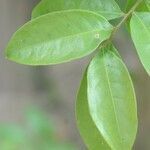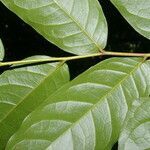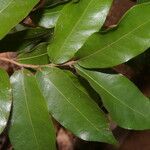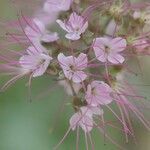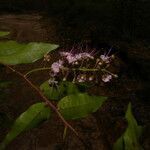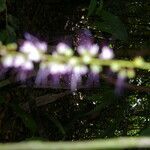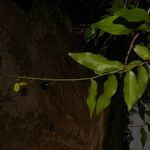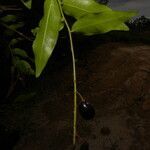mm. in diameter, 2 mm. long; lateral veins 6-8 pairs, arcuate, slightly raised on both surfaces but not forming conspicuous ribs on either, often hardly visible on the upper; glands occurring on the lower surface of the blade near base, mostly nearly circular, about 0.2 mm. across, with raised rim and depressed center; stipules subpersistent, filiform-subulate, appressed-hairy, 2.5-5 mm. long, usually black in dried material, appressed to the branchlets. Flowers in axillary and terminal racemes 12-15 cm. long (or up to 20-25 cm. including the basal leafy part of the growing branchlet terminated-by the raceme); "racemes" 30-to.40-flowered, flowering from base to apex but apparently always determinate, the terminal (bractless) flower abortive; lateral flowers on filiform "pedicels" 5-8 (-12) mm. long, spreading at right angles or somewhat ascending, each with two tiny bracte-oles near base or about one-third the distance from base to apex, the bracteoles often with sessile or stalked glands on the margins, and borne at the summit of a thickened peduncular portion of the flower-stalk (only the part beyond them being the pedicel proper); bracts subtending the flower-stalks lanceolate, usually re-curved, 1-2 mm. long, with basal marginal glands like those of the leaves (and sometimes a similar gland at apex); petals pink, purple or "rosy mauve", glabrous, broadly elliptic, rounded at both ends, 2-3 mm. wide, 3-5 mm. long; stamens 5-7, much exserted, purple, glabrous, the filaments 1.2-1.6 cm. long, fleshy at base and tapering to the very slender tips, arising separately from the fleshy hypanthium-rim which projects 1 mm. or less above the base of the calyx, absent from the segment of the rim opposite the insertion of the ovary or there represented by vestigial staminodia only; anthers about 0.6 mm. long; hypanthium in anthesis elongate-tubular, with hollow cylindric or oblong one-sided base up to about 1 mm. thick and 2 mm. long, and funnelform throat about 1 mm. long, the interior hairy about the summit of the throat, glabrous below; calyx-lobes oblong or elliptic, usually reflexed at anthesis, entire, rounded or subacute at apex, about 1-1.5 mm. wide, 2.5 mm. long, the outer surface with mixed short white and long yellow hairs, the inner surface glabrous proximally, distally white-tomentulose; ovary hirsute, sessile, attached to one side of the funnelform portion of the hypanthium above the bottom; style as in H. americana, but up to about 1.5 cm. long, arising from the flower toward the side where functional stamens are lacking (i. e. the side toward which the inflated base of the hypanthium is expanded). Fruit oblong-obovoid, sparsely hairy, dark red or purple, up to about 1.5 cm. long and 0.6 cm. in diameter, rounded at apex, the base substipitate.
More
Shrub or small tree, 2-3 (-6) m. tall, with slender pubescent branchlets 1-1.5 mm. in diameter below the inflorescence; hairs of two types, those of the young foliage and branchlets yellowish, appressed or erect, straight and slender, pointed, multicellular, 0.5-1.5 mm. long, these also abundant in the inflorescence but there mixed with tiny erect white hairs mostly 0.2-0.3 mm. long. Leaves elliptic to oblong, lanceolate, or ovate, glabrate, only a few long yellow hairs persistent on the veins (at least of the lower surface), a few of the hairs with papillose bases; blades subcoriaceous,'lustrous, 1.5-4 cm. wide, 3-8 cm. long, usually 2-3 times as long as wide, narrowed from the middle or above to a broad blunt or pointed acumen 1 cm. long or less, narrowed and rounded at base (or obtusely narrowed, with the extreme base rounded abruptly into the petiole); petiole short, stout, about 0.7
Lower layers of primary forests, usually on the well-drained soils of hills, slopes and ridges. Primary forest, especially beside rivers and streams, but also in the understorey; on non-flooded ground.
